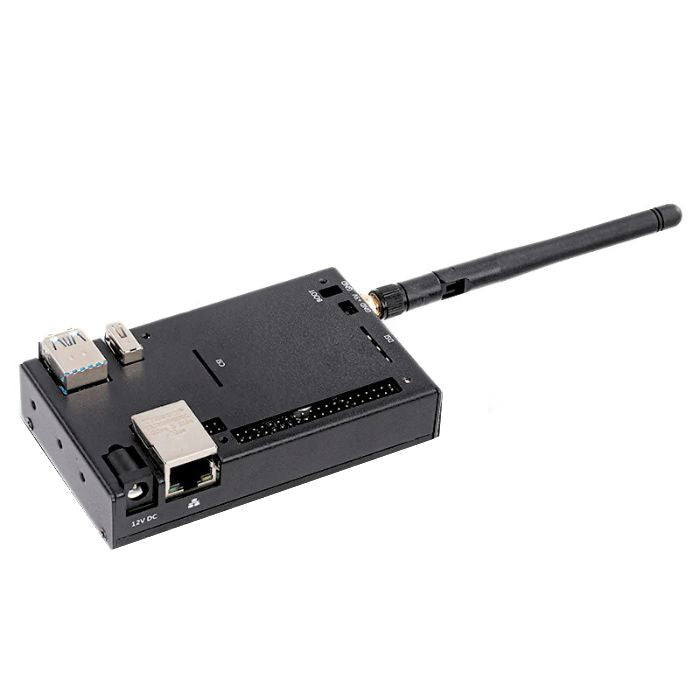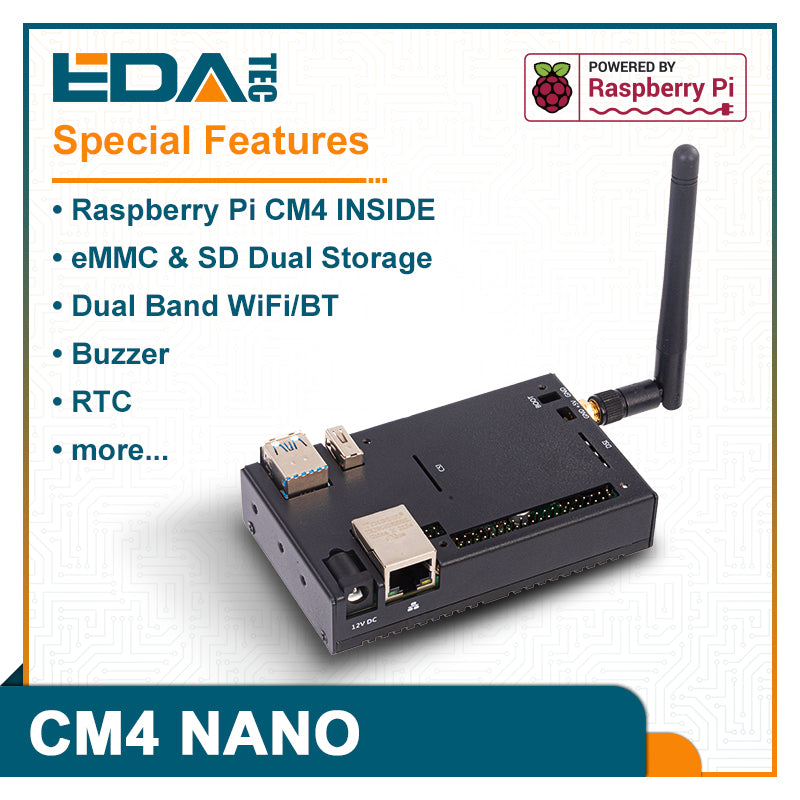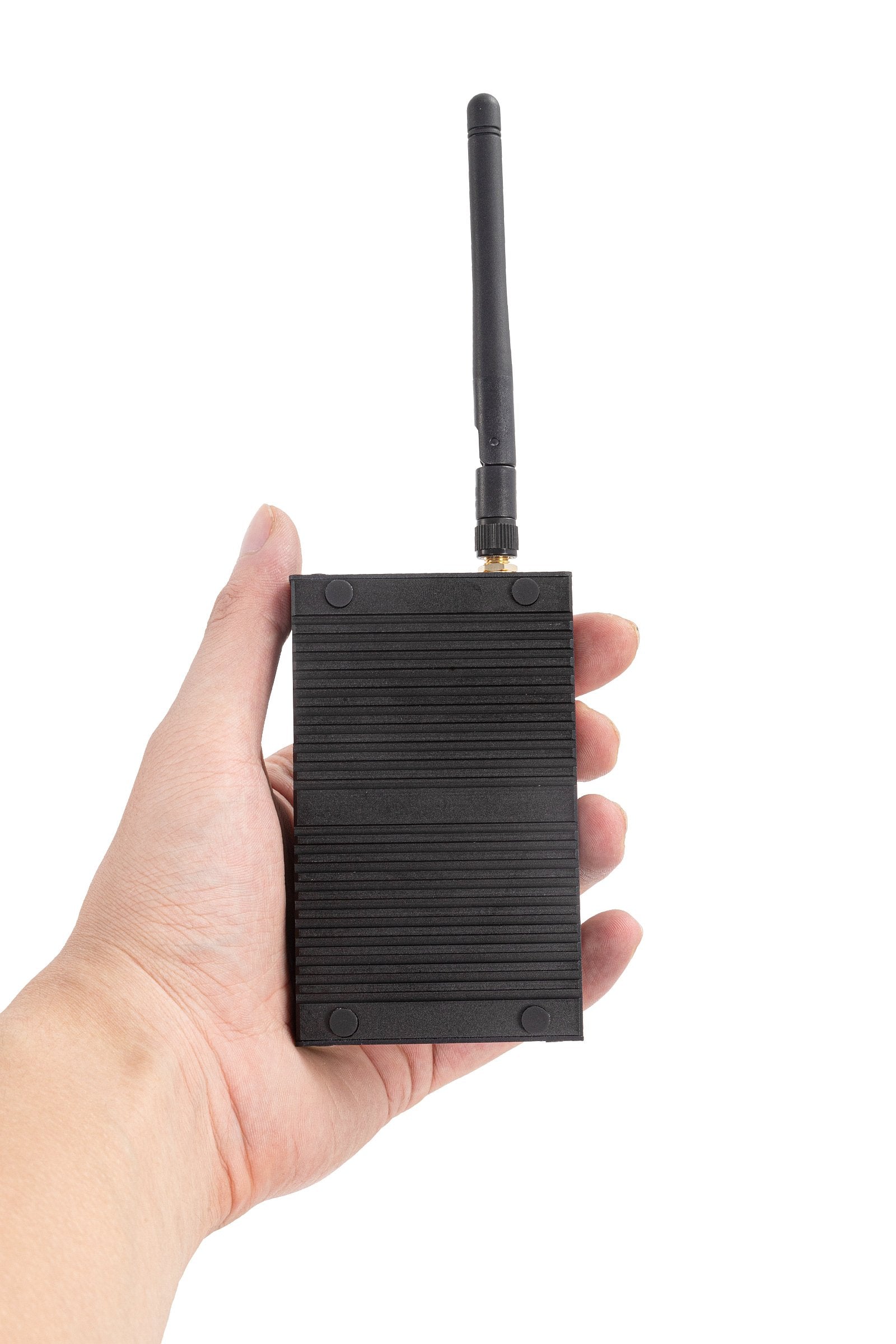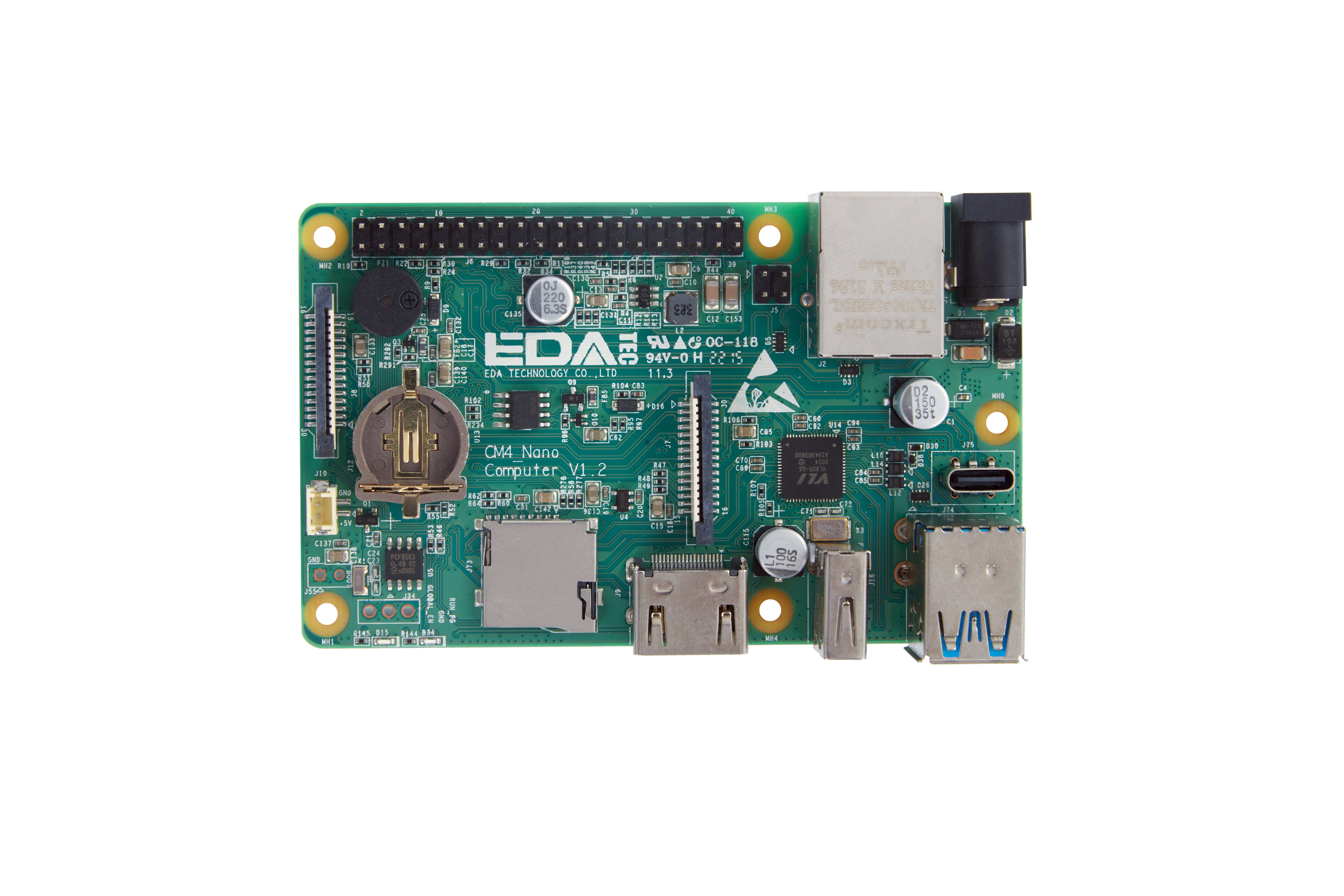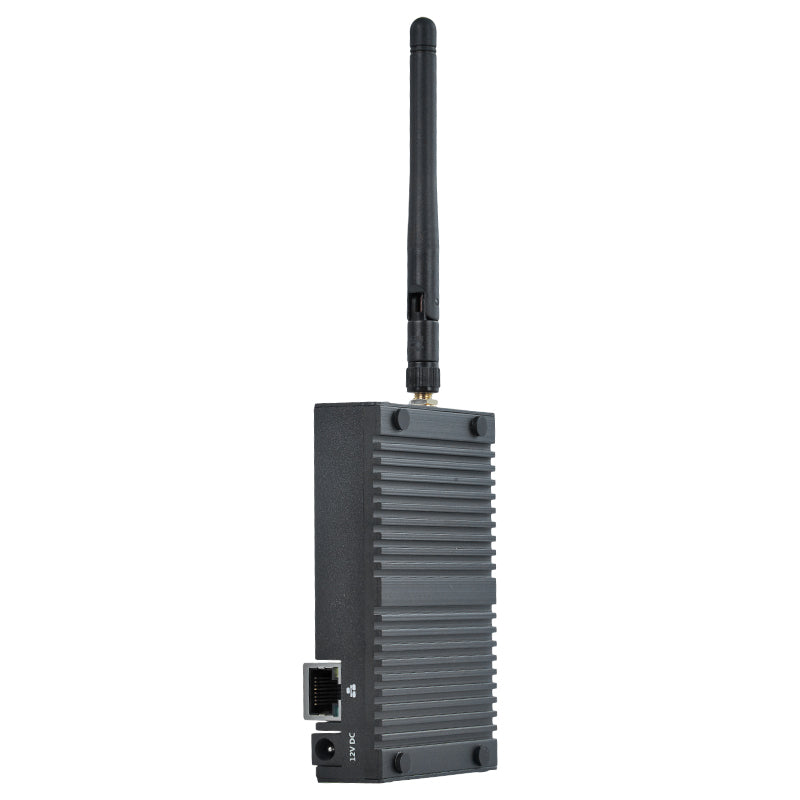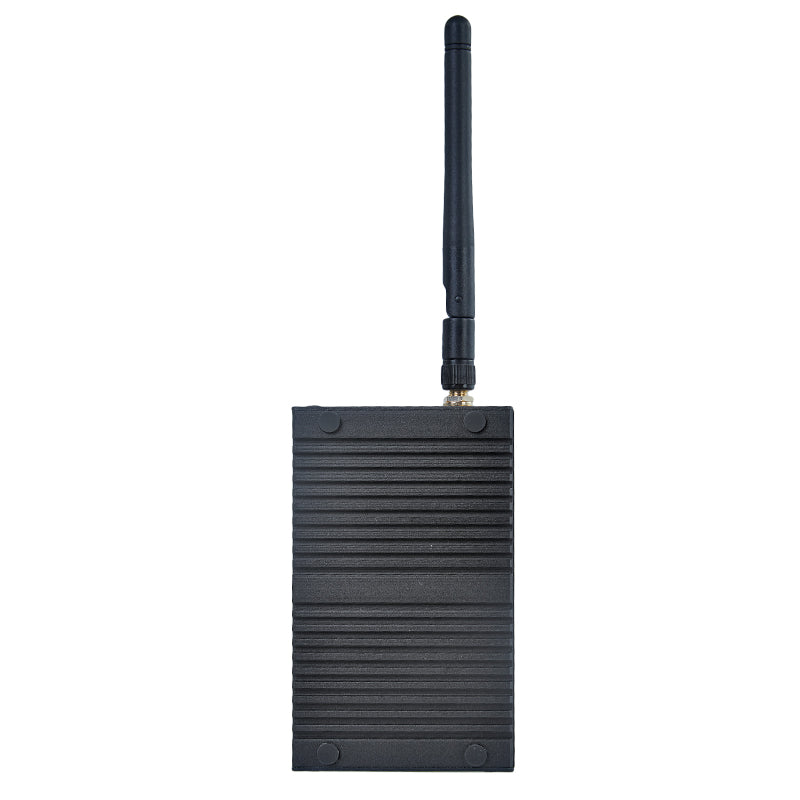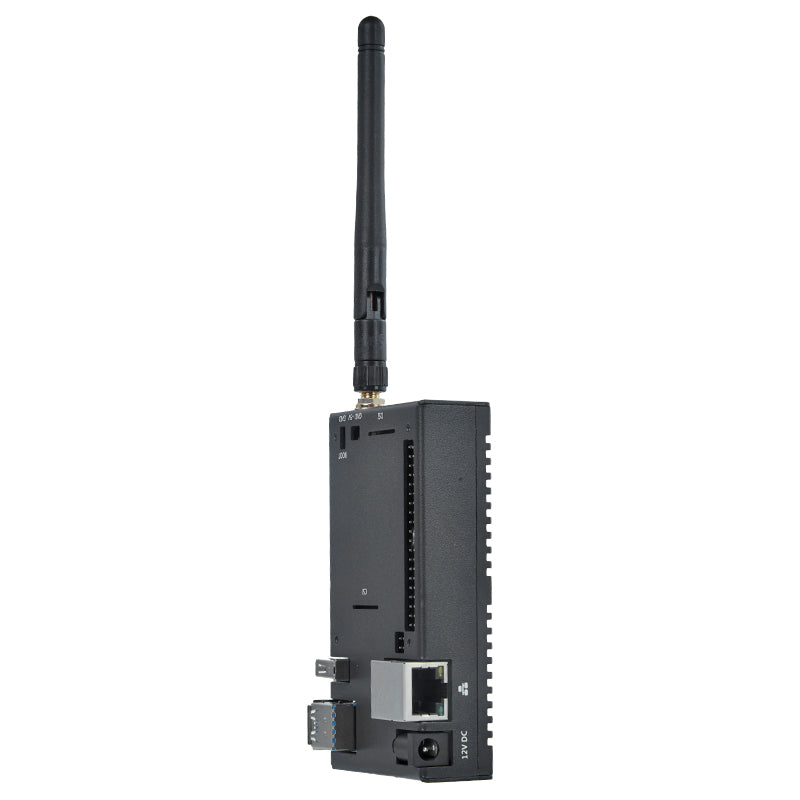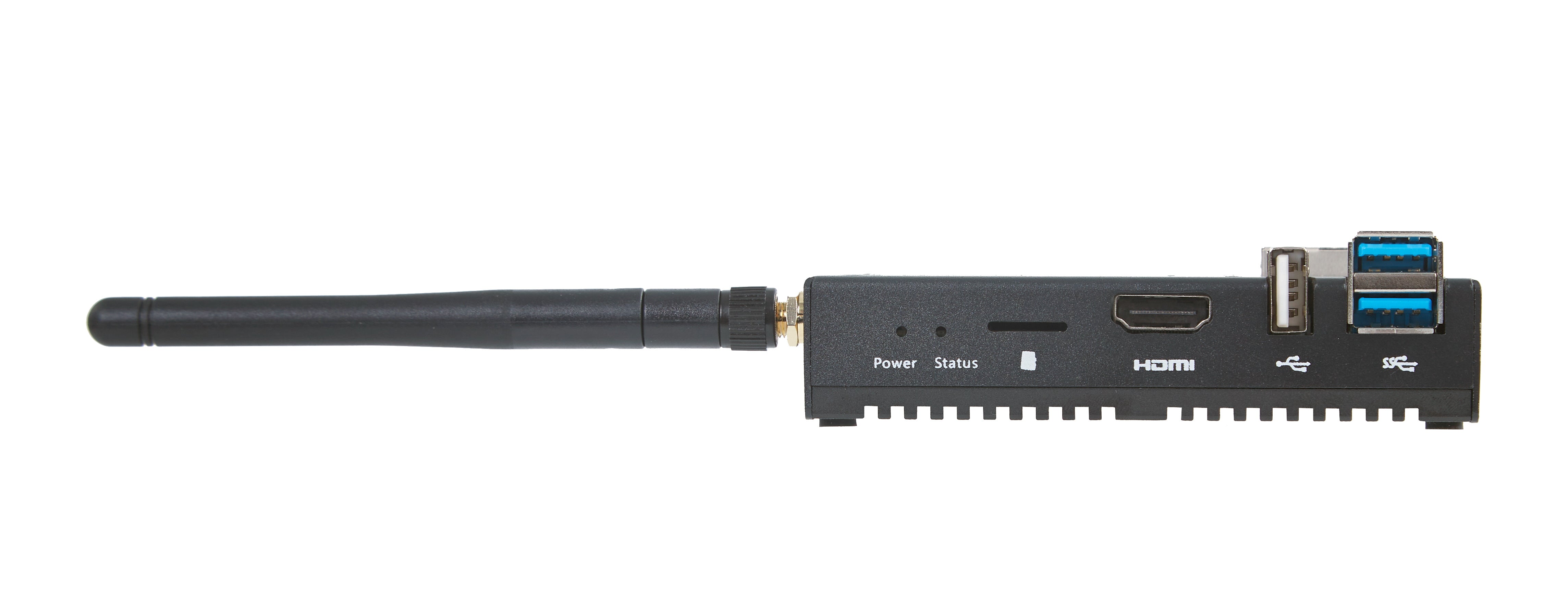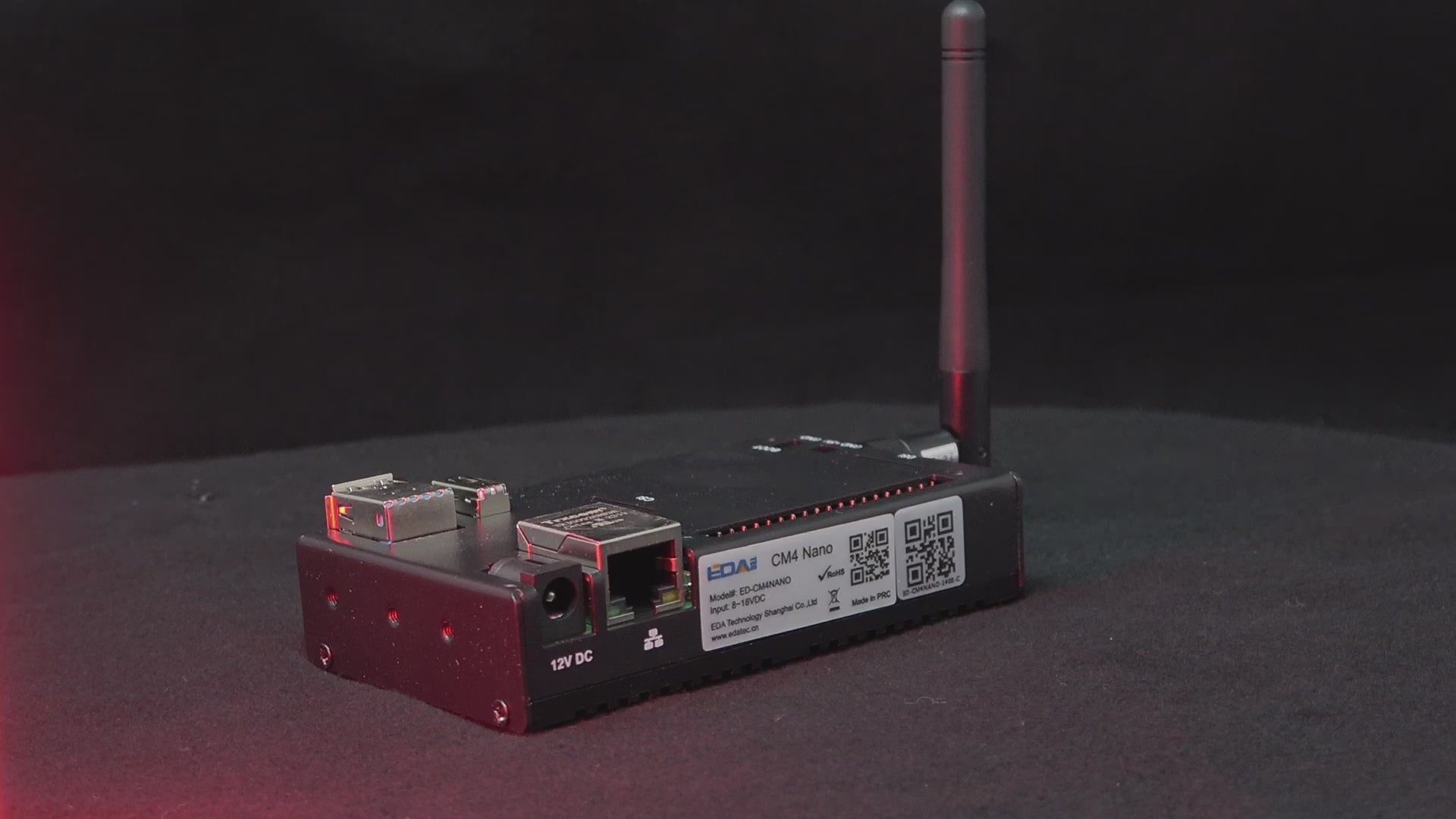Der EDATEC CM4NANO Nano Embedded Computer hat in etwa die Abmessungen von einem Raspberry Pi 4.
Er basiert auf einem CM4 Modul und ist damit voll kompatibel mit Raspberry Pi Software und Hardware, hat jedoch viele Vorteile für industrielle Anwendungen.
Das CM4 Modul ist bereits vorinstalliert und im Lieferumfang mit dabei.
Zum Beispiel könnte dieser industrielle embedded Computer in folgenden Anwendungen zum Einsatz kommen:
- Multimedia Anwendungen
- AI Entwicklung
- Intelligentes Messgerät
- Home Server
- IoT Node
- u.v.m.
Wie von einem Raspberry Pi gewohnt, bietet der Industrierechner eine hervorragende Auswahl von Komunikationsschnittstellen:
- 1 x Gigabit Ethernet mit PoE Unterstützung (benötigt PoE HAT)
- (optional) 2.4 GHz / 5 GHz WLAN - je nach gewähltem CM4
- (optional) Bluetooth - je nach gewähltem CM4
-
1 x HDMI, 1 X FPC HDMI inkl. USB Touch und PWM Dimming
- 2 x Standard USB 3.0 ports
- 1 x Standard USB 2.0 port
- 1 x DSI (Display Interface)
- 1 x CSI port (Camera Interface)
- 40-pin Raspberry Pi GPIO Header
Vier Varianten sind im Standardsortiment, auf Anfrage ist der CM4SEN Computer aber auch mit jedem beliebigen anderen CM4 erhältlich. Technisch ausgeschlossen sind in diesem Fall die CM4 Lite, da EDATEC CM4 Nano nur vom eMMC booten kann.
Empfohlenes Zubehör
Spezifikationen
| CPU | Broadcom BCM2711 4-Kern Cortex A72 1.5GHz (ARM v8) 64-bit CPU |
| RAM | 1GB/2GB/4GB/8GB |
| eMMC Flash | 8GB/16GB/32GB |
| WiFi / Bluetooth | 2.4GHz/5GHz WiFi, Bluetooth BLE5.0 |
| Ethernet | 10/100/1000M LAN-Anschluss mit PoE (benötigt PoE HAT) |
| SD-Karte | Unterstützt microSD-Karte als erweiterten Speicher. Booten von der microSD Karte ist nicht möglich. |
| HDMI | 1x HDMI A |
| HDMI FPC Anschluss | 1 x HDMI + 1 USB Touch + PWM Dimming |
| USB 3.0 | 2 x standard USB 3.0 Anschlüsse |
| USB 2.0 | 1 x standard USB 2.0 Anschluss |
| DSI | 1 x DSI Anschluss |
| CSI | 1 x CSI Anschluss |
| Echtzeituhr | Unterstützt die RTC-Funktion (CR1220 Batterie erforderlich) |
| Summer | 1 Summer |
| 40PIN Anschluss | Standard 40-PIN GPIO Schnittstelle des Raspberry Pi |
| 4 Pin PoE Anschluss | Unterstützt PoE (benötigt PoE HAT) |
| DC-Ausgang | 5V@2A |
| LED-Anzeige | grün (Systemzustand), rot (Strom) |
| Stromversorgungseingang | 7V~18V DC |
| Abmessungen | 103mm(L) x 62mm(B) x 32mm(H) |
| Gehäuse | Aluminiumlegierung für Wärmeableitung |
| Antenne | PCB Antenne/externe Antenne |
| Arbeitsumgebungstemperatur | -25~60°C |
| Betriebssystem | Kompatibel mit dem offiziellen Standard-System |

Am Gerät sind Befestigungslöcher für eine DIN-Schienenhalterung vorgesehen, die eine optionale Montage auf der DIN-Schiene ermöglichen.

Nur die Befestigungslöcher für die Befestigungsösen sind vorgesehen, und die Befestigungsösen sind nicht standardmäßig im Lieferumfang.
PCB Anschlüsse & Funktionen

| Item | Function Description | Item | Function Description |
| A1 | 40PIN | A2 | CSI port |
| A3 | PoE | A4 | gigabit Ethernet |
| A5 | DC power port | A6 | Type-C USB 3.0 port |
| A7 | USB 3.0 | A8 | USB 2.0 |
| A9 | Standard HDMI port | A10 | SD card slot |
Stromeingang
Die Stromversorgungsschnittstelle befindet sich auf der rechten Seite, mit einer DC-Buchsenschnittstelle, die 7 ~ 18V DC-Stromversorgung unterstützt, mit Plus innen und Minus außen. Wir empfehlen, einen 12-V-Netzadapter zu verwenden.

microSD Slot
CM4 Nano unterstützt zwei Speicherorte, den eMMC und eine Micro-SD-Karte. Der eMMC wird dabei für das Hauptdateisystem verwendet und die Micro-SD-Karte kann für die Erweiterung des Datenspeichers verwendet werden.
Die Benutzer können SD-Karten mit mit unterschiedlichen Kapazitäten wählen, um Daten je nach Anwendungsanforderungen zu speichern. Verglichen mit dem eingebauten eMMC-Speicher haben SD-Karten eine größere Kapazität und geringere Kosten.
Der Benutzer kann den eMMC-Speicher des CM4 zum Speichern von Systemcode und die SD-Karte zum Speichern von Anwendungsdaten verwenden.
Tipp: Micro-SD-Karten können nur für die erweiterte Speicherung verwendet werden, CM4 Nano lässt sich nicht von SD-Karten booten.
HDMI
CM4 Nano verfügt über eine Standard-HDMI-Schnittstelle Typ A (Full-Size), die CM4 HDMI0-Signale verwendet und HDMI2.1-Videoausgabe mit einer maximalen Auflösung von 4Kp60 unterstützt.
USB 2.0 Port
CM4 Nano verfügt über 1 USB 2.0 Typ-A, der als Schnittstelle beim Flashen des Systems verwendet wird. Wenn das von EDATEC bereitgestellte BSP im System installiert wurde, kann diese Schnittstelle als gewöhnlicher USB 2.0 Port verwendet werden.
2 x USB 3.0 Ports
Das sind gewöhnliche USB 3.0 Ports, wie auch vom Raspberry PI 4 bekannt.
USB 3.0 Type-C
Ein USB 3.0 Type C Anschluss, an den USB Type C Geräte angeschlossen werden können.
Antennenanschluss
Der ED-CM4NANO Industriecomputer verfügt über eine Standard-SMA-Antennenschnittstellen. Sie ist mit der offiziellen Raspberry Pi WiFi/BT-Antenne kompatibel.
Realtime Clock
Die Echtzeituhr benötigt eine CR1220 Batterie (2mm x 12 mm Durchmesser).
Die Echtzeituhr ist am I2C-0 Bus angeschlossen, mit der Adresse 0x51.
Buzzer
Der engebaute Summer kann durch GPIO6 an- (high) und ausgeschaltet (low) werden.
mini CSI, MIPI DSI, FPC HDMI, USB 2.0
Mehr über diese Interfaces im Datenblatt. FPC HDMI ist ein HDMI Anschluss der über einen Stecker für Folienkabel herausgeführt ist. Zusätzlich sind an diesem Anschluss USB und PWM Helligkeitssignale vorhanden.
Konfiguration und Lieferumfang:
1 Stk. CM4 Nano (im Gehäuse)
1 Stk. Raspberry Pi zertifizierte Antenne für 2.4GHz / 5 GHz WiFi / BT (bei Option WLAN)
FAQ:
Q: Wird PoE unterstützt?
Ja, der EDATEC CM4NANO unterstützt PoE. Dazu wird das offizielle Raspberry Pi PoE HAT benötigt.
Q: Kann eine Micro-SD-Karte zum Starten des Systems verwendet werden?
Nein, CM4NANO kann auf der microSD Karte ausschließlich Daten speichern, es kann nicht davon booten.
Q: Warum funktionieren einige Funktionen nach der Installation der CM4 Industrial Edition im offiziellen System nicht?
Wir empfehlen, dass Kunden das von EDATEC bereitgestellte Systemimage installieren. Andernfalls laden Sie bitte das BSP von EDATEC herunter, um einige externe Schnittstellen nutzen zu können.
Q: Ist irgendein Signal auf dem 40PIN Header des CM4 Nano belegt?
Der Summer belegt GPIO6. Wenn er nicht benötigt wird, kann der Widerstand R39 entfernt und der GPIO6 vom Summerkreis getrennt werden. Die SD-Karte belegt GPIO22, 23, 24, 25, 26, 27. Wenn Sie sie nicht verwenden, bitte stecken Sie die SD-Karte nicht ein.
Q: Wie installiert man ein Spiegelbild?
Sie können die Anweisungen lesen, indem Sie das Softwarehandbuch konsultieren.
Q: Wie löst man den Fehler "config failed, hub doesn't have any ports! (err -19)" beim Öffnen von CM4 Nano?
Löschen Sie "otg_mode=1", [cm4] in config.txt und fügen Sie gleichzeitig "dtoverlay=dwc2,dr_mode=host" hinzu.
Downloads & Support:
Herstellerbezeichnung: EDATEC ED-CM4NANO10-xyzz-(C)
Aktuell sind bei uns ED-CM4NANO-1208-C und ED-CM4NANO-1408-C auf Lager, dieser EDATEC Industrie-Computer kann auf Anfrage sehr flexibel wie folgt konfiguriert werden:
- CM4 mit oder ohne WiFi (0 / 1)
- RAM Größe ( 1 / 2 / 4 / 8 GB)
- eMMC Größe ( 08 / 16 / 32 GB eMMC) (keine Option ohne Flash erhältlich)
- mit / ohne Gehäuse ( <ohne> / C)

Abmessungen:

English Description
The EDATEC CM4NANO Nano Embedded Computer has approximately the dimensions of a Raspberry Pi 4.
It is based on a CM4 module, making it fully compatible with Raspberry Pi software and hardware, but it offers many advantages for industrial applications.
The CM4 module is pre-installed and included in the delivery.
This industrial embedded computer can be used in applications such as:
- Multimedia applications
- AI development
- Intelligent measuring devices
- Home servers
- IoT nodes
- And much more
As expected from a Raspberry Pi, the industrial computer offers an excellent range of communication interfaces:
- 1x Gigabit Ethernet with PoE support (requires PoE HAT)
- (Optional) 2.4 GHz / 5 GHz Wi-Fi - depending on the selected CM4
- (Optional) Bluetooth - depending on the selected CM4
- 1x HDMI, 1x FPC HDMI including USB touch and PWM dimming
- 2x Standard USB 3.0 ports
- 1x Standard USB 2.0 port
- 1x DSI (Display Interface)
- 1x CSI port (Camera Interface)
- 40-pin Raspberry Pi GPIO header
Four variants are in the standard assortment, but on request, the CM4SEN computer can be equipped with any other CM4. However, CM4 Lite is excluded because the EDATEC CM4 Nano can only boot from eMMC.
Specifications
- CPU: Broadcom BCM2711 4-core Cortex A72 1.5GHz (ARM v8) 64-bit CPU
- RAM: 1GB/2GB/4GB/8GB
- eMMC Flash: 8GB/16GB/32GB
- WiFi / Bluetooth: 2.4GHz/5GHz WiFi, Bluetooth BLE5.0
- Ethernet: 10/100/1000M LAN port with PoE (requires PoE HAT)
- SD card: Supports microSD card as extended storage. Booting from microSD card is not possible.
- HDMI: 1x HDMI A
- HDMI FPC connection: 1x HDMI + 1x USB touch + PWM dimming
- USB 3.0: 2x standard USB 3.0 ports
- USB 2.0: 1x standard USB 2.0 port
- DSI: 1x DSI connection
- CSI: 1x CSI connection
- Real-time clock: Supports RTC function (CR1220 battery required)
- Buzzer: 1 buzzer
- 40-pin connector: Standard 40-pin GPIO interface of the Raspberry Pi
- 4-pin PoE connection: Supports PoE (requires PoE HAT)
- DC output: 5V@2A
- LED indicators: Green (system status), Red (power)
- Power input: 7V~18V DC
- Dimensions: 103mm(L) x 62mm(W) x 32mm(H)
- Case: Aluminum alloy for heat dissipation
- Antenna: PCB antenna/external antenna
- Operating environment temperature: -25~60°C
- Operating system: Compatible with the official standard system
The device has mounting holes for a DIN rail bracket, allowing optional mounting on the DIN rail.
Only mounting holes for the brackets are provided, and the brackets are not included in the standard delivery.
PCB Connections & Functions
| Item | Function Description | Item | Function Description |
|---|---|---|---|
| A1 | 40-pin GPIO | A2 | CSI port |
| A3 | PoE | A4 | Gigabit Ethernet |
| A5 | DC power port | A6 | Type-C USB 3.0 port |
| A7 | USB 3.0 | A8 | USB 2.0 |
| A9 | Standard HDMI port | A10 | SD card slot |
Power Input
The power supply interface is located on the right side, with a DC jack supporting 7~18V DC power supply, with positive inside and negative outside. We recommend using a 12V power adapter.
MicroSD Slot
The CM4 Nano supports two storage locations, eMMC and a microSD card. The eMMC is used for the main file system, and the microSD card can be used for data storage expansion.
Users can choose SD cards with different capacities to store data depending on the application requirements. Compared to the built-in eMMC storage, SD cards offer larger capacity and lower costs.
Users can store system code on the eMMC storage of the CM4 and use the SD card to store application data.
Note: MicroSD cards can only be used for extended storage, and the CM4 Nano cannot boot from SD cards.
HDMI
The CM4 Nano has a standard HDMI Type-A interface (full-size), using CM4 HDMI0 signals and supporting HDMI 2.1 video output with a maximum resolution of 4Kp60.
USB 2.0 Port
The CM4 Nano has 1 USB 2.0 Type-A port used for flashing the system. If the BSP provided by EDATEC is installed on the system, this port can be used as a standard USB 2.0 port.
2 x USB 3.0 Ports
These are standard USB 3.0 ports, similar to those on the Raspberry Pi 4.
USB 3.0 Type-C
A USB 3.0 Type-C port for connecting USB Type-C devices.
Antenna Connection
The ED-CM4NANO industrial computer has a standard SMA antenna interface compatible with the official Raspberry Pi Wi-Fi/BT antenna.
Real-Time Clock
The real-time clock requires a CR1220 battery (2mm x 12mm diameter). The real-time clock is connected to the I2C-0 bus, with the address 0x51.
Buzzer
The built-in buzzer can be turned on (high) and off (low) via GPIO6.
Configuration and Delivery Contents
- 1x CM4 Nano (in case)
- 1x Raspberry Pi certified antenna for 2.4GHz/5GHz Wi-Fi/BT (for Wi-Fi option)
FAQ
Q: Does it support PoE?
Yes, the EDATEC CM4NANO supports PoE. The official Raspberry Pi PoE HAT is required.
Q: Can a microSD card be used to boot the system?
No, the CM4NANO can only store data on the microSD card but cannot boot from it.
Q: Why do some functions not work after installing the CM4 Industrial Edition in the official system?
We recommend customers install the system image provided by EDATEC. Alternatively, download the BSP from EDATEC to use some external interfaces.
Q: Is any signal occupied on the 40-pin header of the CM4 Nano?
The buzzer occupies GPIO6. If not needed, remove resistor R39 to disconnect GPIO6 from the buzzer circuit. The SD card occupies GPIO22, 23, 24, 25, 26, 27. If not in use, do not insert the SD card.
Manufacturer Information
EDA Technology Co., LTD
Manufacturer designation: EDATEC ED-CM4NANO10-xyzz-(C)
Currently in stock: ED-CM4NANO-1208-C and ED-CM4NANO-1408-C. This EDATEC industrial computer can be configured flexibly on request as follows:
- CM4 with or without Wi-Fi (0 / 1)
- RAM size (1 / 2 / 4 / 8 GB)
- eMMC size (08 / 16 / 32 GB eMMC) (no option without flash available)
- With or without case (without / C)
Sicherheitsangaben
- Lesen Sie die Bedienungsanleitung sorgfältig durch, bevor Sie das Produkt verwenden.
- Stellen Sie sicher, dass alle Montage- und Installationsanweisungen des Herstellers sorgfältig befolgt werden.
- Verwenden Sie das Produkt nur für den vorgesehenen Zweck.
- Die unsachgemäße Nutzung dieses Produkts kann zu schweren Verletzungen oder Sachschäden führen.
- Nicht für Kinder unter 10 Jahren geeignet.
- Bei unsachgemäßer Verwendung besteht eine Verletzungsgefahr.
- Dieses Produkt entspricht den geltenden Sicherheitsanforderungen der Europäischen Union.
- Dieses Produkt wurde gemäß der GPSR geprüft, die sicherstellt, dass alle relevanten Sicherheitsanforderungen für Konsumgüter eingehalten werden.
Nachverfolgbarkeitsinformationen
Jedes Produkt verfügt über eines oder mehrere der folgenden Merkmale:
- Ein CE-Kennzeichen, das die Einhaltung der Sicherheits-, Gesundheits- und Umweltschutzanforderungen der Europäischen Union anzeigt.
- Eine eindeutige Serien- oder Chargennummer, um die Nachverfolgbarkeit zu gewährleisten und bei Bedarf Rückrufaktionen zu unterstützen.
- Hersteller- und Importeurangaben für den Kundensupport und Sicherheitsanfragen.
Überwachung und Berichterstattung von Vorfällen
Für den unwahrscheinlichen Fall eines Produktproblems haben wir Verfahren implementiert, um:
- Kundenbeschwerden zeitnah bearbeiten.
- Schwerwiegende Vorfälle über das EU Safety Gate/RAPEX-System melden.
- Mit den Marktüberwachungsbehörden zusammenarbeiten, um die öffentliche Sicherheit zu gewährleisten.
Kontakt:
- Email: support [@] pi3g.com
- Telefon: 0341 / 392 858 40
Dieses Produkt ist vollständig mit allen geltenden EU-Vorschriften konform, um die Sicherheit unserer geschätzten Kunden zu gewährleisten.

